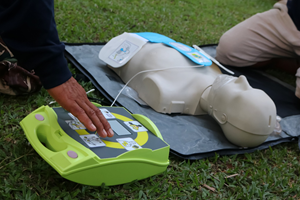Be Ready if an Emergency Strikes: The Importance of High-quality CPR
By nature, many people struggle with what psychologists call an "optimism bias." We never think an unfortunate situation will reach the people we care about — and due to that cognitive bias, many well-meaning individuals assume they will never be faced with the challenge of performing lifesaving CPR to a stranger, friend, or loved one.
However, the reality is that 350,000 out-of-hospital sudden cardiac arrests (SCA) happen in the U.S. every year — and tragically, 90% of those SCA victims die before they reach the hospital. If these same victims had received high-quality CPR soon after collapsing, their chance of survival would have doubled or even tripled. Unfortunately, less than half of sudden cardiac arrest victims receive CPR.
Even the most well-meaning bystanders may be reluctant to intervene in emergencies; they may worry about harming the victim, or doubt their ability to provide high-quality CPR. The best way to prepare for SCA and other medical emergencies is to provide CPR training for individuals within your community and provide the equipment they need to deliver lifesaving care.

What Is CPR and Why Is It Important?
CPR stands for cardiopulmonary resuscitation. When an individual stops breathing, CPR helps to deliver oxygenated blood to the brain and other organs until first responders arrive. This dramatically increases a victim’s chance of survival and reduces the risk of neurological damage.
There are many situations in which CPR can save a life. For example, CPR is often used to help those experiencing sudden cardiac arrest, including SCA resulting from common accidents such as choking, near drowning, or electrical shock. It is also used to help people who suffer strokes, heart attacks, allergic reactions, and other medical conditions.
Because many life-threatening emergencies occur when a trained medical professional is not present, CPR is a crucial skill that everyone should learn. CPR training gives individuals the knowledge required to recognize when CPR is necessary and enables them to deliver lifesaving care at a moment’s notice.
How to Know when CPR Is Necessary
Early intervention is critical to positive outcomes, so it’s important to recognize signs that indicate when CPR is necessary. The moment someone stops spontaneously breathing, it’s time to act.
An obvious sign that someone needs CPR is a sudden collapse. If an individual has collapsed, quickly check to see if they are breathing or if they have a pulse. If you can’t immediately find a pulse or observe that they are spontaneously breathing, ask another bystander to immediately call 911 and locate an AED, then promptly begin administering CPR.
If an individual complains of chest pains, an abnormal heartbeat, or says they are feeling faint, they may be exhibiting early symptoms of cardiac arrest. Encourage the individual to seek medical attention and closely observe them until their symptoms have subsided for an extended period of time. If they become unresponsive at any point, ask another bystander call 911 and locate an AED, and immediately start administering CPR.
What Is High-quality CPR?
High-quality CPR adheres to AHA-recommended guidelines, and it can increase return of spontaneous circulation (ROSC) from 42% to 72%. According to the AHA, high-quality CPR meets the following guidelines:
- Depth: The depth of chest compressions should be between 2 and 2.4 inches. This depth is necessary to help blood flow to the vital organs.
- Rate: Compressions should be delivered at a rate of 100-120 per minute. This rate is fast enough to maintain some circulation while enabling rescuers to maintain consistent delivery.
- Interruptions: Avoid interruptions. A disruption as brief as 10 seconds can drastically decrease the chance of a successful shock.
- Release: Do not lean on the victim’s chest, and fully release each compression to enable the victim’s chest to rise. This will generate negative intrathoracic pressure, which facilitates blood flow.
High-quality CPR will help deliver more oxygenated blood to the brain and other vital organs while you wait for emergency services to arrive.
Anyone Can Help. CPR Saves Lives
Preparedness and training are key to ensuring the best possible outcome for victims in need of CPR. Recognize the signs of SCA, ventricular fibrillation, stroke, and other medical conditions that can render a victim unresponsive and unable to breathe. And learn the four core factors of high-quality CPR: depth, rate, interruptions, and release.
Empower yourself by knowing what to do when someone needs immediate, potentially lifesaving help. Taking the time to learn these skills will give you the confidence you need to help — the moment an emergency happens.
Download our e-book, Why CPR?, to learn more about the importance of CPR. For our full product line, check out our product portfolio of Public Access AEDs.

